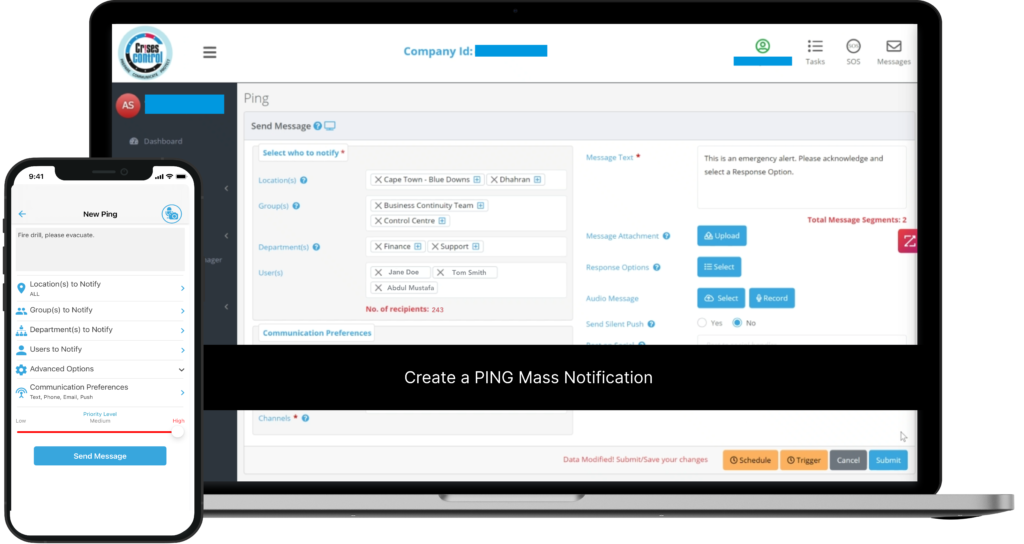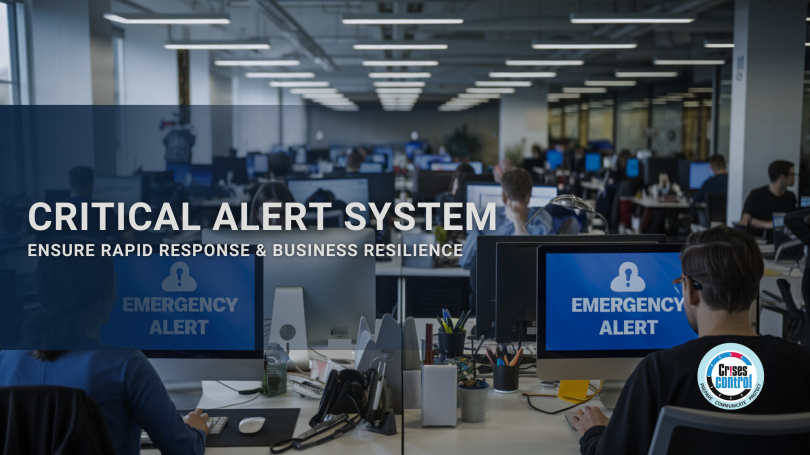Written by Sonny Sehgal | Board Member
Every business faces the risk of sudden disruptions, from severe weather events and cyber-attacks to equipment failures and security threats. Whether it’s a system outage or a natural disaster, responding quickly and effectively is crucial to reducing the impact on people, operations, and your reputation. For this reason, businesses need a robust Critical Alert System to provide reliable, fast communication that mobilises the right people when seconds matter.
This blog explores why a Critical Alert System is essential for organisations aiming to build resilience, protect employees, and manage crises effectively. We’ll also look at how Crises Control stand out in providing swift alerts, organised communication, and complete crisis management support.
I. Why Quick Alerts Matter in Crisis Management
When an emergency strikes, seconds count. A quick and structured response can prevent escalation, reduce financial impact, and help you regain control. Critical Alert Systems allow businesses to reach people in real time, giving clear instructions to those who need it most, wherever they are.
The Power of Instant Alerts in Boosting Business Resilience
- Preventing Escalation: In any crisis, a delayed response can turn a manageable issue into a full-scale disaster. Quick alerts help you nip problems in the bud, keeping situations under control before they impact operations, safety, or reputation.
- Empowering Decision-Makers: Informed decision-making depends on accurate, up-to-the-minute information. With quick alerts, key decision-makers can assess the situation instantly and put recovery plans into action, mitigating potential damage.
How Crises Control Supports Rapid Alerts
Crises Control’s Critical Alert System offers a real-time, multi-channel approach, instantly delivering notifications across SMS, email, mobile app, and voice calls. Paired with an intuitive Incident Management feature, this system empowers managers to assess threats and start targeted communication with a single click.
II. Key Benefits of a Critical Alert System
For organisations looking to maintain smooth operations during disruptive events, the benefits of a Critical Alert System are significant. These systems offer practical solutions for downtime reduction, employee safety, and regulatory compliance, which ultimately contribute to business continuity and resilience.
1. Minimising Downtime and Keeping Operations on Track
Operational downtime during a crisis can lead to financial losses, customer dissatisfaction, and potential regulatory risks. A reliable Critical Alert System helps reduce these impacts by:
- Delivering Instant Notifications: Alert the right people within seconds, reducing the time it takes to mobilise a response team.
- Automating Emergency Protocols: Built-in templates and automated workflows allow you to respond faster, especially during high-stakes situations.
Crises Control’s Advantage in Operational Continuity
Our Ping Mass Notification Software enables your team to send mass notifications in under one minute through various channels, including SMS, email, push notifications, and phone calls. This multi-channel approach ensures that everyone stays informed, regardless of their location.
What sets our software apart is its customisation capability, allowing alerts to be tailored for different departments or locations. Whether you need to inform a specific team about a critical update or alert the entire organisation about an emergency, the right people receive the right message at the right time. Even in remote or decentralised environments, our system guarantees that no team member is left out. By keeping everyone connected and informed, Crises Control significantly reduces the chaos typically associated with emergencies.
2. Enhancing Employee Safety and Communication
Employee safety is a priority in any emergency plan, whether it’s a fire, severe weather, or a workplace security threat. A Critical Alert System ensures that employees are informed, equipped with the necessary safety instructions, and able to reach out for help when needed.
- Real-Time Safety Alerts: Provide employees with real-time information on risks, evacuation routes, or actions they need to take.
- Two-Way Communication: A good system enables employees to share their status or ask for help, helping you make informed decisions about their safety.
How Crises Control Puts Safety First
Crises Control includes a dedicated SOS Panic Button, allowing employees to signal for help with a tap on their mobile device. During evacuations or active threats, the geolocation feature helps track the location of team members, making it easier for safety teams to monitor and support them effectively.
3. Building Trust and Transparency with Stakeholders
During a crisis, keeping stakeholders—clients, employees, and regulators—updated with accurate information is critical. Timely communication reassures them that the situation is under control, preserving their confidence in your organisation.
- Clear, Regular Updates: Stakeholders need to know the status of the crisis and what’s being done to manage it. Real-time alerts ensure they’re informed every step of the way.
- Incident Tracking for Accountability: Documenting the progress of incidents ensures accountability and provides valuable data for future analysis.
Crises Control’s Role in Transparency
With Crises Control’s Critical Event Management System, you can send timely updates and monitor incident progression in real time. The platform’s comprehensive reporting tools make it easy to document each action taken, allowing for transparent communication with stakeholders.
4. Meeting Industry Compliance and Regulatory Requirements
In industries like finance, healthcare, and manufacturing, strict regulatory requirements often mandate immediate notification protocols during crises. A Critical Alert System helps organisations meet these standards by:
- Providing Detailed Documentation: Record every action taken during an incident, creating a comprehensive log for audit purposes.
- Meeting Notification Standards: Notify specific personnel or agencies within required timeframes, supporting compliance with industry standards.
Crises Control’s Compliance Support
Crises Control’s reporting features include detailed audit logs, making it easier for your organisation to meet regulatory standards and produce documentation for any required reporting. This ensures that your emergency response not only meets legal requirements, but also stands up to future scrutiny.
Interested in our Critical Alert System?
Efficiently alert everyone in seconds at scale with our Mass Notification System – PING, get the message out fast and ensure rapid response and recovery.

III. Essential Features of an Effective Critical Alert System
When selecting a Critical Alert System, it’s important to consider specific features that ensure effective communication, organisation, and resilience during emergencies.
Real-Time, Multi-Channel Alerts
A powerful alert system should deliver notifications instantly across multiple channels, including SMS, email, push notifications, and voice calls. Multi-channel capability ensures that the message reaches the intended recipients, regardless of their device or location.
Crises Control’s Real-Time Communication: With SMS, email, voice calls, and in-app notifications, Crises Control ensures alerts reach your team wherever they are, enabling quick action when needed most.
Incident Tracking with Customisable Templates
A robust alert system should offer real-time tracking and customisable templates, allowing organisations to initiate protocols specific to their needs. This feature aids in assessing incident progress, improving response time, and adjusting actions based on real-time feedback.
Crises Control’s Incident Management Features: Our system includes incident tracking and customisable alert templates that suit various crisis scenarios. With templates and workflows ready to activate in one click, your team can focus on effective response rather than scrambling for solutions during a crisis.
Geolocation and Interactive Communication
Geolocation capabilities enable organisations to track the location of employees and resources, especially crucial in large facilities or during outdoor operations. Two-way communication allows team members to confirm receipt of alerts and update their status, providing real-time situational awareness.
How Crises Control Integrates Geolocation: Crises Control offers geolocation tracking and two-way communication tools, allowing you to locate team members in real time and gather valuable information from those on the ground.
Detailed Reporting for Post-Incident Review
Post-incident analysis is essential for improving future responses. A Critical Alert System should include detailed reporting and review features that track each alert, response, and action, providing a foundation for training and compliance.
Crises Control’s Comprehensive Reporting Tools: Our platform includes robust reporting and audit capabilities, enabling your team to conduct thorough post-incident reviews. These insights help improve future response strategies, ensure compliance, and support training programs for better crisis readiness.
IV. Crises Control in Action: Real-World Impact of a Critical Alert System
Imagine a major retailer experiencing a data breach. Here’s how a Critical Alert System, powered by Crises Control, would help manage the crisis:
- Immediate Notification: IT teams receive instant alerts about the breach, allowing them to mobilise and begin containment efforts within seconds.
- Automated Workflows: Crises Control’s system initiates predefined protocols, keeping sensitive data secure while minimising exposure.
- Real-Time Updates for Stakeholders: Executives, clients, and regulatory bodies receive timely updates, ensuring transparency and maintaining trust.
- Complete Documentation for Compliance: Every action is logged, providing comprehensive records to support post-incident analysis and compliance reporting.
In this example, the ability to communicate instantly, coordinate efforts, and track progress illustrates how a Critical Alert System can be the difference between a minor incident and a major crisis.
V. Build Resilience with Crises Control’s Critical Alert System
In today’s fast-paced, interconnected world, a Critical Alert System isn’t a “nice-to-have”—it’s essential for protecting your people, operations, and reputation. By providing reliable, rapid communication, organisations can minimise the impact of crises and build a stronger foundation for business continuity.
Ready to see how Crises Control’s Critical Alert System can enhance your emergency response capabilities? Contact us today to schedule a free personalised demo, and discover how our solutions can safeguard your organisation, support compliance, and ensure your team is always prepared for the unexpected.
Request a FREE Demo

